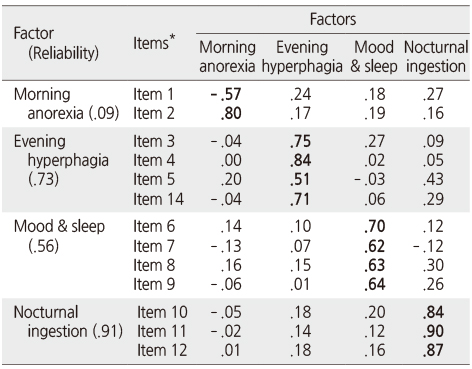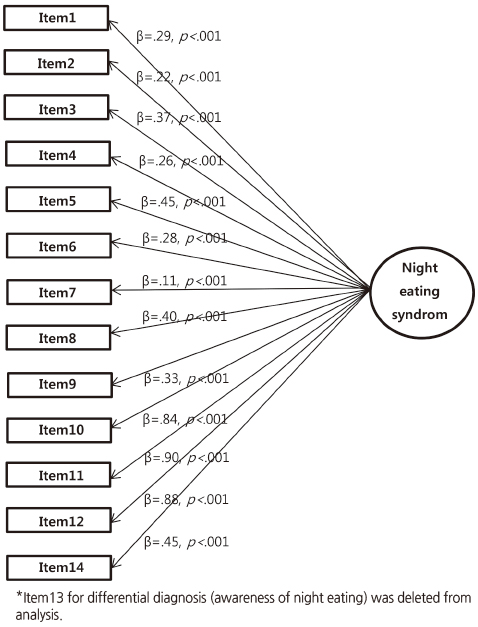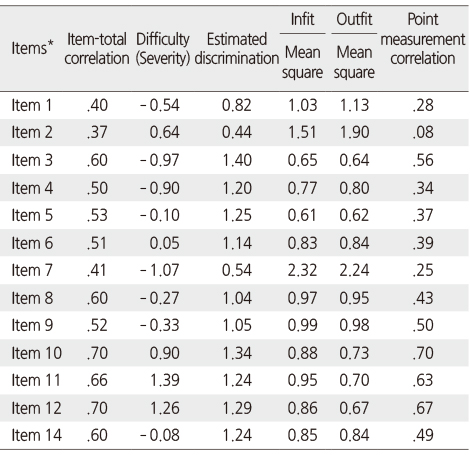Articles
- Page Path
- HOME > J Korean Acad Nurs > Volume 46(1); 2016 > Article
-
Original Article
- Psychometric Properties and Item Evaluation of Korean Version of Night Eating Questionnaire (KNEQ)
- Beomjong Kim, Inja Kim, Heejung Choi
-
Journal of Korean Academy of Nursing 2016;46(1):109-117.
DOI: https://doi.org/10.4040/jkan.2016.46.1.109
Published online: February 29, 2016
1Department of Business Administration, Seowon University, Cheongju, Korea.
2Department of Nursing, Daejeon University, Daejeon, Korea.
3Department of Nursing, Konkuk University, Chungju, Korea.
- Address reprint requests to: Choi, Heejung. Department of Nursing, Konkuk University, 268 Chungwon-daero, Chungju 27478, Korea. Tel: +82-43-840-3954, Fax: +82-43-840-9329, hjchoi98@kku.ac.kr
© 2016 Korean Society of Nursing Science
This is an Open Access article distributed under the terms of the Creative Commons Attribution NoDerivs License. (http://creativecommons.org/licenses/by-nd/4.0/) If the original work is properly cited and retained without any modification or reproduction, it can be used and re-distributed in any format and medium.
Abstract
-
Purpose
- The aim of this study was to develop a Korean version of Night Eating Questionnaire (KNEQ) and test its psychometric properties and evaluate items according to item response theory.
-
Methods
- The 14-item NEQ as a measure of severity of the night eating syndrome was translated into Korean, and then this KNEQ was evaluated. A total of 1171 participants aged 20 to 50 completed the KNEQ on the Internet. To test reliability and validity, Cronbach's alpha, correlation, simple regression, and factor analysis were used. Each item was analyzed according to Rasch-Andrich rating scale model and item difficulty, discrimination, infit/outfit, and point measure correlation were evaluated.
-
Results
- Construct validity was evident. Cronbach's alpha was .78. The items of evening hyperphagia and nocturnal ingestion showed high ability in discriminating people with night eating syndrome, while items of morning anorexia and mood/sleep provided relatively little information. The results of item analysis showed that item2 and item7 needed to be revised to improve the reliability of KNEQ.
-
Conclusion
- KNEQ is an appropriate instrument to measure severity of night eating syndrome with good validity and reliability. However, further studies are needed to find cut-off scores to screen persons with night eating syndrome.
This study was supported by Kuhnil Phamaceutical Co., Ltd. 2013.
The authors declared no conflict of interest.
- 1. Eating Disorders Victoria. Classifying eating disorders-DSM-5: Diagnostic and statistical manual of mental disorders [Internet]. Victoria, AU, Author. 2015;cited 2015 July 30. Available from: https://www.eatingdisorders.org.au/eating-disorders/what-is-an-eating-disorder/classifying-eating-disorders/dsm-5
- 2. Birketvedt GS, Florholmen J, Sundsfjord J, Osterud B, Dinges D, Bilker W, et al. Behavioral and neuroendocrine characteristics of the night-eating syndrome. JAMA. 1999;282(7):657–663.ArticlePubMed
- 3. Milano W, De Rosa M, Milano L, Capasso A. Night eating syndrome: An overview. J Pharm Pharmacol. 2012;64(1):2–10. ArticlePubMedPDF
- 4. Allison KC, Ahima RS, O'Reardon JP, Dinges DF, Sharma V, Cummings DE, et al. Neuroendocrine profiles associated with energy intake, sleep, and stress in the night eating syndrome. J Clin Endocrinol Metab. 2005;90(11):6214–6217. ArticlePubMed
- 5. Howell MJ, Schenck CH, Crow SJ. A review of nighttime eating disorders. Sleep Med Rev. 2009;13(1):23–34. ArticlePubMed
- 6. de Zwaan M, Roerig DB, Crosby RD, Karaz S, Mitchell JE. Nighttime eating: A descriptive study. Int J Eat Disord. 2006;39(3):224–232. ArticlePubMed
- 7. Kim MH, Jeong ES, Kim EJ, Cho HK, Bae YJ, Choi MK. Night eating status of university students in partial area of Chungnam. J East Asian Soc Diet Life. 2011;21(4):563–576.
- 8. Hong SH, Yeon JY, Bae YJ. Relationship among night eating and nutrient intakes status in university students. J East Asian Soc Diet Life. 2013;23(3):297–310.
- 9. Allison KC, Lundgren JD, Moore RH, O'Reardon JP, Stunkard AJ. Cognitive behavior therapy for night eating syndrome: A pilot study. Am J Psychother. 2010;64(1):91–106.ArticlePubMed
- 10. Pawlow LA, O'Neil PM, Malcolm RJ. Night eating syndrome: Effects of brief relaxation training on stress, mood, hunger, and eating patterns. Int J Obes Relat Metab Disord. 2003;27(8):970–978. ArticlePubMedPDF
- 11. Stunkard AJ, Grace WJ, Wolff HG. The night-eating syndrome; A pattern of food intake among certain obese patients. Am J Med. 1955;19(1):78–86.PubMed
- 12. Vander Wal JS. Night eating syndrome: A critical review of the literature. Clin Psychol Rev. 2012;32(1):49–59. ArticlePubMed
- 13. Allison KC, Lundgren JD, O'Reardon JP, Geliebter A, Gluck ME, Vinai P, et al. Proposed diagnostic criteria for night eating syndrome. Int J Eat Disord. 2010;43(3):241–247. ArticlePubMedPMC
- 14. Allison KC, Lundgren JD, O'Reardon JP, Martino NS, Sarwer DB, Wadden TA, et al. The Night Eating Questionnaire (NEQ): Psychometric properties of a measure of severity of the night eating syndrome. Eat Behav. 2008;9(1):62–72. ArticlePubMed
- 15. Brislin RW. Back-translation for cross-cultural research. J Cross Cult Psychol. 1970;1(3):185–216. ArticlePDF
- 16. Kim I, Choi H, Kim B. Psychometric properties of Korean version of modified Leeds Sleep Evaluation Questionnaire (KMLSEQ). Korean J Rehabil Nurs. 2014;17(1):10–17.Article
- 17. Cho MJ, Kim KH. Diagnostic validity of the CES-D (Korean version) in the assessment of DSM-III-R major depression. J Korean Neuropsychiatr Assoc. 1993;32(3):381–399.
- 18. Cohen S. Laboratory for the study of stress, immunity and disease [Internet]. Pittsburgh, PA, Carnegie Mellon University. 2014;cited 2015 July 30. Available from: http://www.psy.cmu.edu/~scohen/
- 19. Linacre JM. FACETS: Rasch measurement computer program. Chicago, IL: Winsteps.com; 2005.
- 20. Seong TJ. Understanding and application of item response theory. Paju: Kyoyookbook; 2009.
- 21. Ware JE Jr., Gandek B. Methods for testing data quality, scaling assumptions, and reliability: The IQOLA project approach. J Clin Epidemiol. 1998;51(11):945–952. PubMed
- 22. Wright B, Linacre JM. Reasonable mean-square fit values [Internet]. Chicago, IL, Institute for Objective Measurement. 2012;cited 2014 August 14. Available from: http://www.rasch.org/rmt/rmt83b.htm
- 23. Linacre JM. Facets: Many-facet rasch measurement tutorials: WINSTEPS & fcets rasch software [Internet]. Beaverton, OR, Winsteps.com. 2012;cited 2014 July 7. Available from: http://www.winsteps.com/tutorials.htm
- 24. Allison KC, Engel SG, Crosby RD, de Zwaan M, OReardon JP, Wonderlich SA, et al. Evaluation of diagnostic criteria for night eating syndrome using item response theory analysis. Eat Behav. 2008;9(4):398–407. ArticlePubMedPMC
- 25. Bond TG, Fox CM. Applying the rasch model: Fundamental measurement in the human sciences. 2nd ed. Mahwah, NJ: Lawrence Erlbaum Associates; 2007.
- 26. Lundgren JD, Allison KC, Vinai P, Gluck ME. Assessment instruments for night eating syndrome. In: Lundgren JD, Allison KC, Stunkard AJ, editors. Night eating syndrome: Research, assessment, and treatment. New York, NY: Guilford Press; 2012. p. 197–220.
REFERENCES
Rotated Factor Loading Matrix (N=1,162)

*Item 13 for differential diagnosis was deleted from analysis; Item1: How hungry are you usually in the morning?; Item 2: When do you usually eat for the first time?; Item 3: Do you have cravings or urges to eat snacks after supper, but before bedtime?; Item 4: How much control do you have over your eating between supper and bedtime?; Item 5: How much of your daily food intake do you consume after suppertime?; Item 6: Are you currently feeling blue or down in the dumps?; Item 7: When are you feeling blue, is your mood lower in the: ; Item 8: How often do you have trouble getting to sleep?; Item 9: Other than only to use the bathroom, how often do you get up at least once in the middle of the night?; Item 10: Do you have cravings or urges to eat snacks when you wake up at night?; Item 11: Do you need to eat in order to get back to sleep when you wake at night?; Item 12: When you get up in the middle of the night, how often do you snack?; Item 13: When you snack in the middle of the night, how aware are you of your eating?; Item 14: How much control do you have over your eating while you are up at night?.
Figure & Data
REFERENCES
Citations

- Effects of night eating on oral health characteristics and symptoms of poor oral health in adolescents: a cross-sectional study using the 18th Korea Youth Risk Behavior Survey
Seung–Hee Hong
Korean Journal of Community Nutrition.2025; 30(2): 150. CrossRef - The Night Eating Questionnaire through the lens of the Rasch model
Vojkan Aleksic, Marija Milic, Jelena Dotlic, Biljana Jeremic, Branislav Djerkovic, Ivan Radic, Ana Karanovic, Ljiljana Kulic, Milivoje Galjak, Tatjana Gazibara
Heliyon.2024; 10(11): e31929. CrossRef - The association between night eating syndrome and health-related quality of life in Korean adults: a nationwide study
Woorim Kim, Yeong Jun Ju, Soon Young Lee
Eating and Weight Disorders - Studies on Anorexia, Bulimia and Obesity.2023;[Epub] CrossRef - The association between episodes of night eating and levels of depression in the general population
Woorim Kim, Yeong Jun Ju, Soon Young Lee
International Journal of Eating Disorders.2022; 55(2): 254. CrossRef - Validity and Reliability of the Korean Version of Assessment of Health Literacy in Breast and Cervical Cancer Screening
Hye Sook Shin, Eunlim Chi, Hae-Ra Han
Journal of Korean Academy of Nursing.2021; 51(6): 769. CrossRef - Factors Affecting the Quality of Sleep in Young Adults
Ae Kyung Chang, Kyung Hye Lee, Chong Mi Chang, Jin Yi Choi
Journal of Korean Academy of Community Health Nursing.2021; 32(4): 497. CrossRef - Psychometric properties and gender invariance of the simplified Chinese version of Night Eating Questionnaire in a large sample of mainland Chinese college students
Jinbo He, Feng Ji, Xiaoya Zhang, Xitao Fan
Eating and Weight Disorders - Studies on Anorexia, Bulimia and Obesity.2019; 24(1): 57. CrossRef - Night Eating Habits of High School Students by Sex in Gyeonggi Region
Hee Jin Kim, Yeong Kim
Journal of the East Asian Society of Dietary Life.2019; 29(1): 56. CrossRef - Lived Experiences toward Harmful Work Environment among Clinical Nurses: Phenomenological Approach
Yeong Ju Ko, Gwi-Ryung Son Hong
Journal of Korean Academy of Nursing Administration.2018; 24(3): 173. CrossRef - Effects of Psychiatric Nurses' Secondary Traumatic Stress and Compassion Satisfaction on Burnout: The Moderating Effect of Social Support
Hyun Jung Lee, Ji Young Kim
Journal of Korean Academy of Psychiatric and Mental Health Nursing.2016; 25(4): 399. CrossRef

Figure 1
Characteristics of Participants (N=1,171)
BMI=Body mass index; KNEQ=Korean version of Night Eating Questionnaire.
Rotated Factor Loading Matrix (N=1,162)
*Item 13 for differential diagnosis was deleted from analysis; Item1: How hungry are you usually in the morning?; Item 2: When do you usually eat for the first time?; Item 3: Do you have cravings or urges to eat snacks after supper, but before bedtime?; Item 4: How much control do you have over your eating between supper and bedtime?; Item 5: How much of your daily food intake do you consume after suppertime?; Item 6: Are you currently feeling blue or down in the dumps?; Item 7: When are you feeling blue, is your mood lower in the: ; Item 8: How often do you have trouble getting to sleep?; Item 9: Other than only to use the bathroom, how often do you get up at least once in the middle of the night?; Item 10: Do you have cravings or urges to eat snacks when you wake up at night?; Item 11: Do you need to eat in order to get back to sleep when you wake at night?; Item 12: When you get up in the middle of the night, how often do you snack?; Item 13: When you snack in the middle of the night, how aware are you of your eating?; Item 14: How much control do you have over your eating while you are up at night?.
Results of Item Analysis (N=1,162)
*Item 13 for differential diagnosis was deleted from analysis.
BMI=Body mass index; KNEQ=Korean version of Night Eating Questionnaire.
*Item 13 for differential diagnosis was deleted from analysis; Item1: How hungry are you usually in the morning?; Item 2: When do you usually eat for the first time?; Item 3: Do you have cravings or urges to eat snacks after supper, but before bedtime?; Item 4: How much control do you have over your eating between supper and bedtime?; Item 5: How much of your daily food intake do you consume after suppertime?; Item 6: Are you currently feeling blue or down in the dumps?; Item 7: When are you feeling blue, is your mood lower in the: ; Item 8: How often do you have trouble getting to sleep?; Item 9: Other than only to use the bathroom, how often do you get up at least once in the middle of the night?; Item 10: Do you have cravings or urges to eat snacks when you wake up at night?; Item 11: Do you need to eat in order to get back to sleep when you wake at night?; Item 12: When you get up in the middle of the night, how often do you snack?; Item 13: When you snack in the middle of the night, how aware are you of your eating?; Item 14: How much control do you have over your eating while you are up at night?.
*Item 13 for differential diagnosis was deleted from analysis.
 KSNS
KSNS
 E-SUBMISSION
E-SUBMISSION



 Cite
Cite

